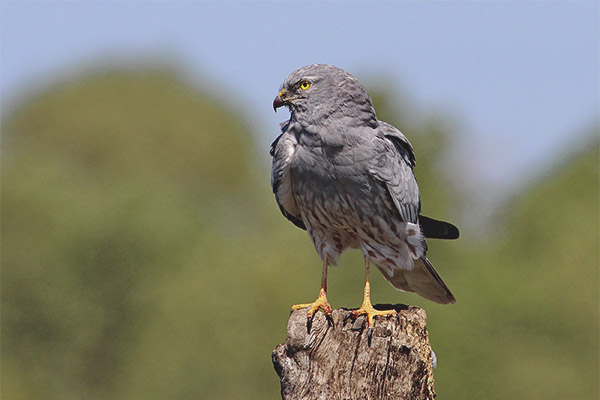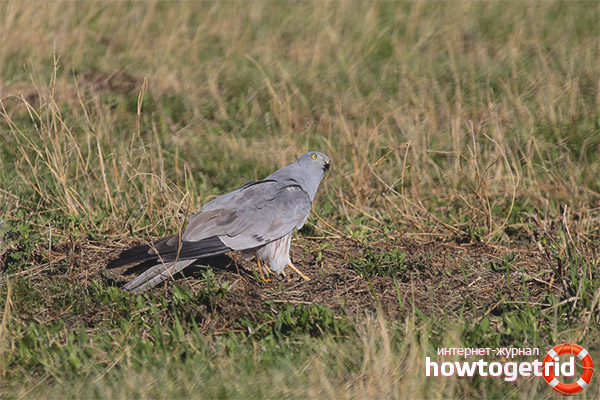The content of the article
Meadow moon means bird, which by its dimensional characteristics is a little more than a crow. These individuals prefer to dwell in temperate climatic regions, such as fields, meadow areas, marshlands. Nests are not built on water and rocks, but on dry soil. Home for posterity is usually located among the shrubs and away from human eyes. The basis of the diet consists of small rodents. Consider other characteristics associated with this bird.
Description
- Representatives of the family are very elegant, with narrow and elongated wings. The tail is also long, giving the bird a larger format. During the flight they do not go to the sky, they prefer to stay above the ground. The wings do not straighten in a straight line, but on the contrary, bend them in the form of a check mark. In the process of moving through the air slow, smooth.
- This species of individuals is about 45–52 cm in length.The wingspan of birds hardly reaches 115 cm. As for the weight category, it depends on the habitat. Individuals from the European region weigh about 0.3 kg. (males) and 0.4 kg (females). If in this plan we compare the moon, then it is a little less of the gray crow and more of the pigeon.
- It makes sense to describe the characteristics of plumage. Males are easiest to distinguish from similar species of individuals. He has a head, feather wings of wing wings, his back is painted ash-gray. The head in the front, as well as the chest and throat are light gray. The area under the tail and abdominal parts are whitish. They have a patterned pattern of brown or reddish feathers.
- Young animals are not painted as brightly as adults. They acquire the characteristic color of plumage closer to 4 years. Birds that are a year old are similar to females and males, it is difficult to understand what kind of sex they are. The lower section of the hull is red with brown, and the upper is dark and brown. Bill is black. The iris is yellowish, in young they are brown or gray-yellow.
Habitat
- These birds are quite extensive.They inhabit the countries of Africa, settled in large numbers in Algeria and Morocco. There are birds in the Altai Mountains, on the west Atlantic coast, as well as in the Minusinsk Basin and near the Tannu-Ola ridge.
- They live everywhere in Europe, but they prefer to avoid Norway. In England, these birds used to be very small (no more than 30 individuals). In Austria in the 2000s there were about 12 pairs, and in Serbia only 10 birds. In Montenegro, no more, about 5 couples.
- In the west of Europe things were much better. So, for example, most of the population is dispersed in Spain, France and Portugal. In the expanses of our homeland, these birds are much more than anywhere else. In Russia, more than 40 thousand individuals. It all depends on the region, the number of birds is reduced, then increases.
- If we consider the European part as the area of distribution of individuals of the species represented by the breed, they most often live there in Estonia, Great Britain, and Sweden. In the expanses of our country they are met in Tyumen, Pskov, Yekaterinburg, Yaroslavl, Moscow, Tara and Kazan.
- It will also be interesting to study the distribution of these birds outside the Russian Federation in the direction of the Caucasus, Iran, Kazakhstan and Central Asia. They are found in China, Asia Minor, and occasionally Japan.
Breeding
- Individuals reach sexual maturity at the age of 2-3 years. In this case, regardless of whether it is a female or a male. The birds are monogamous and faithful to each other for the rest of their lives. The represented individuals often try to nest in the same place. Therefore, after the migration, the Luni try to return to their native lands.
- As soon as the male arrives from the warm countries, he immediately starts the marriage dances in the sky. The bird demonstrates really complex stunts in the air. It moves at a high height in waves, after which it spirals downward. It may show an uncontrolled fall.
- During the performance of various pirouettes, the male simultaneously begins to whistle melodiously. Such sounds are somewhat similar to the cries of a snipe. It is worth noting that females also take an active part in such games. However, they do not do so much in contrast to the males.
- In addition, often during the mating season, the males imitate an attack on the females, they knock them on their backs. If food conditions permit, the individuals in question may often nest in small groups. Most often, the birds still keep in pairs. However, often there are colonies.
- However, to nest in colonies is not typical for all other moons, except meadow ones. In this case, the distance between the nests of the birds in question can be from 10 to 100 m. It is worth noting that only the female is engaged in the construction of the dwelling. Often the nest is located in high thickets of shrubs or grass.
- Externally, the nest may look different. The reason for this may be unequal soil moisture. If the terrain is relatively wet, the nest will consist of grass or straw with a diameter of up to 70 cm. At the same time, the wall thickness can reach up to 20 cm. Often, the base of the nest is small branches.
- If the terrain is arid, for example, in the steppe nests can be found in the form of depressions in the ground. This will still be laid out dry grass. It should be noted that in such dwellings the birds do not make bedding. At the same time the area around the nest is open. Such dwellings of the Lunei can be found in the fields, in the meadows and not damp areas of the marshes.
- After the mating season, the female starts laying eggs. She does it for 1 pc. every two days. The procedure often falls on the beginning of the summer. As a result, birds generally produce up to 6 eggs.But as a rule, the pair stops only at two. At the same time, the eggs are white with a green tint. Rarely there are brown blotches.
- Only the female is engaged in vidis eggs. At this time, the male protects the home and provides the family with food. Often the female meets her half when he returns from the hunt. It is worth noting that the individuals in question are very secretive. If they see danger, they begin to circle the predator and make loud noises.
- If individuals live in colonies, they gather in a flock and begin to protect their relatives from danger. As a result, the effectiveness of defense increases significantly. It is worth noting that the meadow moons do not possess strong aggression towards a person, in contrast to fellow similar species. They are also loyal to the approaching large animals.
- Chicks are born already in white fluff. This happens a little more than a month after vidis. The first 15 days the female does not leave the nest, and all the time remains with the offspring. At this time, the male does not stop bringing food to the whole family. After another 2 weeks, the chicks are already on the wing.
Today we reviewed the bird of a predatory family,which by its dimensional features practically does not exceed the size of a crow. Individuals are more common in the open spaces of the Russian Federation. In the 2000s, they were not known to Europeans, but then the population grew, the birds became larger.
Video: Meadow harrier (Circus pygargus)












To send